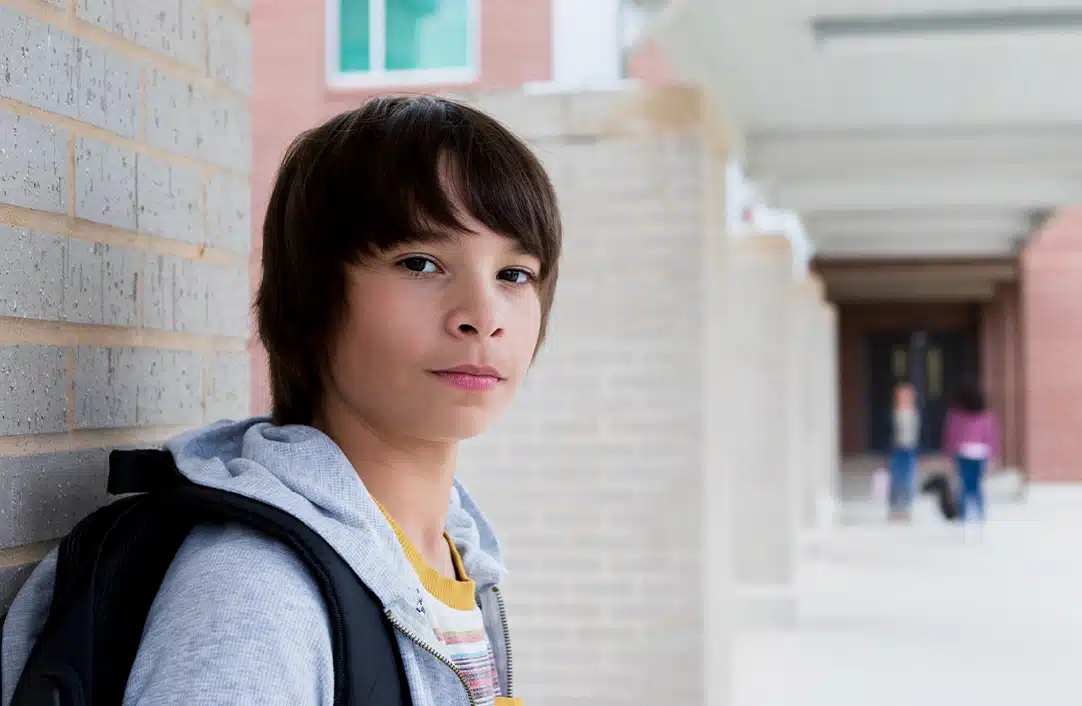It can be overwhelming to navigate through all the risks and dangers that we need to be aware of to keep our children safe. Below you’ll find a list of 11 risk increasers for child sexual abuse, along with tips on how to minimize them. This list is not intended to cause you alarm but to equip you with tools to protect and empower your child.
Risk Increaser 1:
Stressful Home Environment
Children with low self-confidence in their surroundings, particularly at home, are vulnerable to an adult who promises stability and security, even if the stability comes with other unwanted behaviors. Children with a stressful home life may also feel that they cannot confide in a parent because the parent is already burdened with so many problems and may not respond well.
Tip:
It is impossible to avoid stress, especially as a parent. But being aware of how your stress affects your child and how you can manage it will go a long way. Continually assure your child that they can always confide in you, no matter how stressed you may appear. If your child does confide in you, follow through on those assurances you made. If you are in a situation or relationship that is unsafe for you and your child, get help immediately. It is important to remove a child (and yourself) from a harmful environment as soon as possible.
Risk Increaser 2:
Low Self-Esteem
Children with low self-esteem are especially vulnerable due to needs for affection, admiration, and acceptance. This is especially true for children who are targets of bullying or whose parents also display low self-esteem. Children with low self-esteem are more likely to be drawn to those who offer flattery, gifts, and special attention. Without feelings of self-worth, a child may not see the value in the boundaries, respect, and consent they are entitled to.
Tip:
You can help your child build their self-esteem by identifying a hobby, activity, or skill they enjoy. Examples may include sports, performing arts, academic teams, crafts, or other extracurricular activities. Engage in these activities with your child; encourage and praise their participation. Another useful technique is assigning your child responsibilities around the house and rewarding them when those responsibilities are carried out. This will reinforce your child’s identity as a valued and contributing member of the household. If you discover your child is being bullied, address the issue immediately. Also, try to be cognizant of how you talk about yourself around your child. You are your child’s number one example. If you model having a positive self-image and positive self-talk, your child will likely follow suit.
Risk Increaser 3:
Unmonitored Access to Technology
Technology provides limitless ways to nurture your child’s education, creativity, and communication. Unfortunately, technology is also a perpetrator’s playground. The internet provides them with significantly greater access to potential targets along with added anonymity and the ability to keep things secret. The phones, tablets, or laptops in your home can be gateways for interaction between a perpetrator and your child. Not only do these devices greatly expand a perpetrator’s reach, but they remove many barriers to perpetration (such as trying to isolate a child or being able to send inappropriate material).
Tip:
Keep tabs on your child’s computer access, emails, text messages, and social media platforms. Be mindful of every internet-enabled device under your roof, where they are, who is using them, and what sites are frequently viewed. You may also consider knowing your child’s passwords and restricting the use of internet-enabled devices in your child’s bedroom. You could also have a conversation with your child about navigating through images that portray sexuality, including how to recognize these images and what to do when they come across them.
Risk Increaser 4:
Poor Communication
Children who do not feel that they can be open with their parents may become distant, isolated, and insecure, and therefore more susceptible to a perpetrator’s grooming. They are less likely to confide in their parents about important topics such as the new adults in their life, inappropriate behavior they are witnessing or experiencing, or physical changes their body is going through. If or when sexual abuse begins, a child who has poor communication with their parents will likely keep it a secret. They may live in fear of getting in trouble, being judged or shamed, overburdening their parents, or being ignored.
Tip:
Communication is key to preventing child sexual abuse. You can make all the difference by initiating continuous, two-way, age-appropriate discussions with your child that fit their level of maturity and understanding. Ask open-ended questions about your child’s feelings, interactions, and day-to-day experiences. Answer whatever questions your child has with age-appropriate sensitivity, no matter how uncomfortable the conversation may be. If you establish this pattern of open communication with your child early, they will make it a habit of confiding in you for support when they need it most.
Risk Increaser 5:
Loneliness
Loneliness is a powerful emotion. It can lead to feelings of neglect, isolation, and alienation. A crucial step in a perpetrator’s grooming is isolating the child from their loved ones, both emotionally and physically. If a child is already feeling isolated, this step will be much easier for a perpetrator to achieve. Also, if a child is left alone or unsupervised on a frequent basis, a perpetrator has more opportunities to get close to that child.
Tip:
Loneliness stands little chance against a parent who is present and engaged. Be wary about leaving your child at home without adequate supervision from a trustworthy individual for extended periods of time. This may be difficult for single parents or in a household where both parents are working. If your situation does require you to be away from your child for long periods of time, ensure they are in the care of a trusted adult and communicate with your child through frequent check-ins. Express your care and involvement to reinforce that your child isn’t alone.
Risk Increaser 6:
Children Who Identify as LGBTQ+
Children who identify as LGBTQ+ or are in the process of understanding their sexual and/or gender identity can be at risk of feeling socially isolated and alienated from their peers. The fear, anxiety, and uncertainty they may experience could lead them to view themselves as an outsider with no emotional support. A perpetrator may pick up on this vulnerability and need for guidance and might seek to convince the child that they are the only one who understands and accepts them. The child may have heard the many myths surrounding sexual abuse and sexual orientation and become hesitant to disclose. When a child is afraid to open up to their parents about their sexuality, a perpetrator can use that secret against them to prevent the abuse from being disclosed.
Tip:
A major fear a child can have when accepting their sexual identity or gender identity is how their parents will respond to it. In fact, this fear may overshadow all others. To dissuade this fear, establish an environment where your child can feel safe discussing these topics. Encourage them to be open with you through continual, two-way communication. If your child does open up to you about their sexual orientation or gender identity, respond in a calm and loving manner. Ask questions and actively listen to show that their thoughts and feelings matter.
Risk Increaser 7:
Misunderstanding Boundaries
One of the most significant risk increasers for child sexual abuse is insufficient education or understanding about boundaries. Children who do not have a clear understanding of boundaries are highly unlikely to distinguish between appropriate and inappropriate behavior. They may not understand when someone has violated their personal boundaries or when they have violated the boundaries of someone else. With an unclear understanding of what constitutes abuse, they are less likely to disclose any sexually abusive behavior they witness, experience, or hear about. They may also engage in or demonstrate inappropriate behavior that could draw the attention of potential perpetrators.
Tip:
Starting at an early age, teach your child about boundaries. This doesn’t necessarily mean discussing mature topics such as intercourse or sexual abuse with your toddler. Rather, it means teaching them their bodies are important, and certain parts of their bodies shouldn’t be touched by anyone without their permission (in the case of a doctor or a parent at bath time). It also means communicating right and wrong behaviors in how your child interacts with others. Clear and consistent boundaries will empower and protect your child with the knowledge and confidence they need to stay safe.
Your child needs boundaries in order to develop self-confidence and self-esteem. Within these boundaries, however, allowing your child certain age-appropriate freedom is vitally important.
—Joelle Casteix
Risk Increaser 8:
Disabilities
Children with a disability are at least three times more likely to be sexually abused. There are multiple reasons behind this statistic, including the child’s need for personal care, a desire for acceptance, a reliance on others, an inability to escape due to physical limitations, an inability to disclose abuse due to limitations in communication, and a lack of education on healthy sexuality and sexual abuse.
Tip:
If your child has a disability, teach them the importance of body privacy, appropriate boundaries, and the role of consent. Establish open communication habits by having ongoing discussions about healthy sexuality. For children with communication difficulties, provide a way they can report abuse that sufficiently meets their communication needs. If a child is displaying significant changes or new challenges in behavior, consider the possibility that they are responses to abuse. If sexual abuse does occur, report it immediately.
Risk Increaser 9:
Blended Families
In a blended family, communication and relationship dynamics are complicated. There may be disagreements among parents on how to educate about boundaries, conflict resolution, privacy, and healthy sexuality. Tension among family members and stepfamily members may lead to more conflict in the home, which may lead to children having lower confidence in their environment. Blended families also increase a child’s chances of encountering a perpetrator, be it an adult (a stepparent, a live-in partner) or a peer (a stepsibling).
Tip:
With more variables at play in a blended family, more effort may need to be put into consistent and open communication. To ensure consistency and clarity, all caretakers involved need to be on the same page regarding education on safe boundaries, appropriate behavior, and healthy sexuality. Be attentive and alert toward all family members and the new dynamics that develop. Ask your child open-ended questions about their experiences, feelings, and interactions with the rest of the family. If you notice any red flag behavior among family members, address it immediately.
Risk Increaser 10:
Domestic Abuse
In a home where various forms of abuse, neglect, and maltreatment are occurring, sexual abuse is likely a high risk as well. This is particularly the case in homes with physical abuse. Domestic violence fosters a home environment of instability, insecurity, poor communication, and mishandled aggression. It may also correlate with alcohol or substance abuse among one or more family members. Each of these factors increase the risk for child sexual abuse. According to researcher Danielle A. Black, the risk of intra-familial child sexual abuse is six times greater in a family where the mother is a victim of partner aggression.
Tip:
If you are in a domestic abuse relationship, get help immediately. Do what you can to remove your child from the dangerous environment as soon as possible. Likewise, if you have addiction issues with drugs or alcohol, seek help immediately. Resources are available at The Hotline, Crisis Text Line, and Alcohol Abuse Hotline. The longer your child is exposed to an unstable and threatening environment, the higher the risk of abuse will be. If possible, relocate your child to a safe space with an adult you trust.
Risk Increaser 11:
Prior Sexual Abuse
Children who have been victims of prior sexual abuse are at a higher risk of being abused again. This is known as revictimization. A child survivor who lacks the support network and tools to cope with their trauma may become more vulnerable to a recurrence of sexual abuse, whether in childhood, adolescence, or adulthood. Also, a child who has been subjected to sexual abuse that has not been dealt with is likely still in an at-risk environment that allows the abuse to continue.
Tip:
If you discover that a child—whether your own or someone else’s—is being sexually abused, report the abuse immediately. Do everything in your power to prevent the abuse from continuing. Provide emotional support, patience, and empathy to the survivor to help strengthen their resilience and self-esteem, as well as providing them with access to therapy. A crucial element of this support is protecting the survivor against feelings of shame, guilt, and self-blame. Your response may be the most important factor in your child’s healing journey, including the prevention of revictimization. In fact, research suggests that a family’s support may be more influential to a survivor’s recovery than the severity of the abuse that took place.
Parenting is never easy, but by utilizing this information, you can be empowered to improve your child’s safety and wellbeing. Ultimately, follow your instincts. No one knows your child and their situation better than you do. The most important thing is to be there for your child, let them know how much you love them, and to keep being the amazing parent you are.
About the author
Breeann Allison
Research and Program Development Strategist
Breeann joined Saprea as an Education Coordinator at the end of 2018. She holds a Bachelor of Arts degree in English literature with a minor in editing from Brigham Young University. Currently she works as a member of the Research and Program Development Team and a co-teacher for the Saprea Healing Webinar. She is also the author of Saprea's Reclaim Hope Workbook and co-author of Why Do I Still Feel This Way: Changing Your Relationship with the Trauma of Child Sexual Abuse. She has worked in publishing for seven years, first as a curriculum developer at Gibbs Smith Education and then as an editor at FranklinCovey. On the side she enjoys writing mediocre fiction, spoiling her nieces and nephews, and defending the sacredness of the Oxford comma.
Recent blogs

Common Symptoms Experienced by Adult Survivors of Child Sexual Abuse
Childhood sexual abuse can have long-lasting debilitating effects throughout the life of a survivor. The impacts of sexual trauma are profound and far-reaching, affecting every aspect of an individual’s life—physically, psychologically, cognitively, and socially. But why is this so?
Read this article

Statute of Limitations on Sexual Abuse
In our work with individuals who were sexually abused, they often discuss the burden that comes with weighing difficult questions about when to come forward with details of the abuse they experienced. They wonder if they should take legal action or if that is even an option when the abuse occurred many years in the past.
Read this article

Effects of Child Sexual Abuse
As a clinician on the Saprea Clinical Intake team, I am often the first point of contact for anyone seeking one of our services. This gives me the opportunity to talk to many survivors of child sexual abuse. I’m often asked about specific effects of sexual abuse that the women I talk to are experiencing.
Read this article

